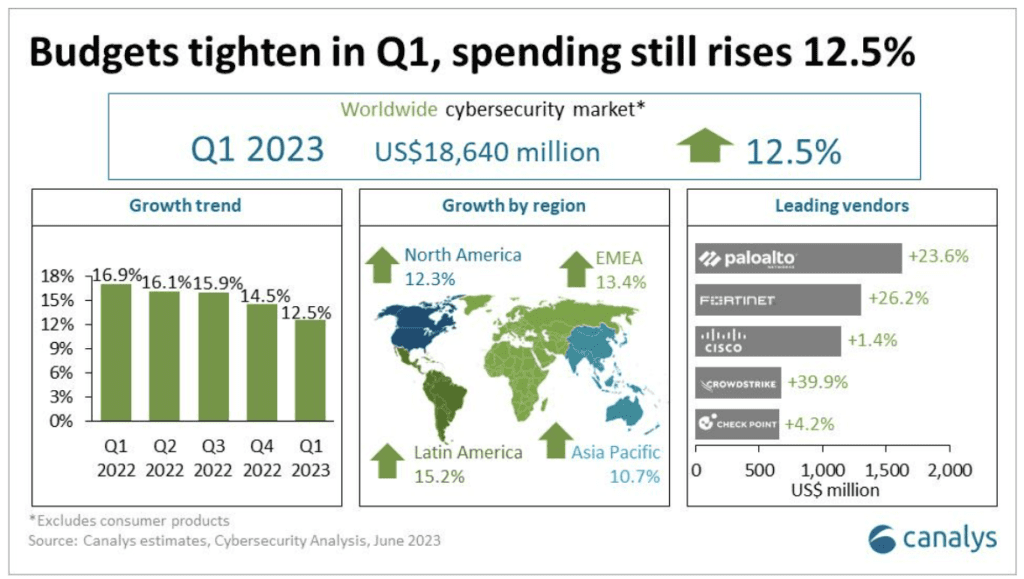In the ever-evolving landscape of cybersecurity, service providers play a vital role in protecting organizations from threats and helping them fortify their security. As we delve into the second half of 2023, cybersecurity service providers must stay ahead of the curve and be aware of the latest trends shaping the industry. From burgeoning market growth to the rise of transformative technologies, here are the top trends and statistics that will define the realm of cybersecurity services this year.
1. Accelerated market growth and shifting priorities
According to Canalys, the global cybersecurity market experienced a remarkable 12.5% year-on-year growth in Q1 2023, reaching an impressive $18.6 billion. This growth outpaced the rest of the tech sector, despite challenging macroeconomic conditions. Identity security remains a top priority, with a growth rate of 14.3%.
Moreover, securing hybrid workers has driven investment in Secure Service Edge (SSE) within web and email security, with a growth of 16.0%.

Image source: Canalys
However, while organizations continue to prioritize enhancing cyber-resiliency, budget constraints and increased scrutiny over IT expenditures will influence their decision-making process. Cybersecurity service providers must anticipate intensifying competition and find opportunities to upsell additional subscriptions to existing accounts. It’s imperative to navigate this landscape and deliver solutions that meet the evolving needs of organizations while optimizing cost-effectiveness.
2. Platform strategies for improved security posture
Organizations are currently wrestling with the intricate complexities and financial burdens of their existing cybersecurity deployments. The accumulation of disparate point products over time has led to vendor sprawl, creating a formidable challenge. However, amidst this challenge lies a significant opportunity for vendors with platform strategies.
By embracing the latest cybersecurity capabilities and reducing complexity, organizations can effectively mitigate potential disruptions and financial losses resulting from successful attacks. Cybersecurity service providers are well-positioned to capitalize on this demand by offering integrated platform solutions that streamline security operations and deliver comprehensive protection.
3. Rise of cybersecurity managed services
A recent report by Canalys reveals that the demand for cybersecurity managed services is projected to grow significantly in 2023, with a 16% increase to $70.2 billion. Managed services present the most substantial growth opportunity for cybersecurity service providers. However, succeeding in this space requires a diversified approach beyond traditional administration management.
Customers now seek operational-focused managed services, including setup, configuration modification, patching, monitoring, and disaster recovery. Bridging the workforce gap and addressing these operational challenges will be paramount for service providers looking to capitalize on this growing market.
4. The emergence of Generative AI in cybersecurity
Projections indicate that within the next five years, over 70% of businesses will rely on generative AI tools to bolster their cybersecurity operations. While the potential of generative AI is vast, it does come with its fair share of challenges.
Threat actors are quick to recognize the advantages of generative AI and will harness its power to maximize the monetization of their attacks. Simultaneously, technology vendors are integrating generative AI into their offerings to drive subscriptions, seize upsell opportunities, and enhance customer retention rates. As a result, cybersecurity service providers must closely monitor this emerging trend and wholeheartedly embrace generative AI in their solutions.
By doing so, they can position themselves at the forefront of innovation, deliver exceptional cybersecurity services, and maintain a competitive edge in the ever-evolving landscape of digital security.
5. Unleashing the power of threat detection and response
In an era where cyberattacks have shifted from being a mere possibility to an inevitable occurrence, organizations are laser-focused on their ability to swiftly identify and respond to any suspicious activity within their entire ecosystem. To meet this challenge head-on, they are turning to advanced threat detection and response tools like Endpoint Detection and Response (EDR), Extended Detection and Response (XDR), and Managed Detection and Response (MDR).
These powerful technologies leverage historical data analysis, artificial intelligence, machine learning algorithms, threat intelligence, and advanced file analysis to effectively detect and neutralize sophisticated threats that can bypass traditional defense measures.
As the demand for robust detection and response capabilities intensifies, the market for cloud-based solutions in this domain is set to experience a substantial surge. By offering innovative cloud-based detection and response offerings, service providers can empower organizations with the tools they need to combat the ever-evolving threat landscape and safeguard their digital assets.
6. Remote work remains a catalyst for security investments
The paradigm shift towards remote and hybrid work, initially propelled by the Covid-19 pandemic, remains a driving force behind investments in security. Organizations are proactively searching for solutions that enable secure work-from-home environments, resulting in a heightened demand for technologies like Web Application Firewalls (WAF), Access Management (AM), Endpoint Protection Platform (EPP), and Secure Web Gateway (SWG).
To seize the opportunities presented by this trend, cybersecurity service providers must leverage their expertise to offer agile and effective solutions that empower organizations to establish and maintain secure remote and hybrid work environments.
7. The rise and rise of Zero Trust Network Access (ZTNA)
Zero Trust Network Access (ZTNA) is skyrocketing as the fastest-growing segment in network security, with a projected growth rate of 31% in 2023. The surge in ZTNA adoption is driven by the escalating demand for zero trust protection among remote workers, as well as organizations’ diminishing reliance on VPNs for secure access.
As businesses become more familiar with the benefits of ZTNA, they are extending its implementation beyond remote work scenarios to encompass workers within office environments as well. Notably, according to Gartner’s forecast, by 2025, most new remote access deployments will predominantly favor ZTNA over VPN services.
8. Human error is the top cyber threat
The Thales Global Data Threat Report 2023 reveals that 77% of respondents identify human error as the top cyber threat. This highlights the growing importance of addressing the human element in cybersecurity strategies. This makes security and risk management leaders rethink their investments across technology, structural elements, and human-centric approaches to design and implement effective cybersecurity programs.

Cybersecurity service providers can play a crucial role in developing comprehensive solutions that account for the human factor, such as user training, awareness campaigns, and security culture development.
Overcoming key challenges
Top cybersecurity challenges faced by organizations and how cybersecurity service providers can help solve them:

Spending too much time tackling emergencies: Organizations often find themselves in a perpetual reactive mode, constantly dealing with emerging threats and emergencies. Cybersecurity service providers can help by implementing proactive measures such as continuous monitoring, threat intelligence, and advanced detection technologies.
Difficulty in keeping up with security requirements: According to the report, State of Security 2023 by Splunk, the ever-evolving threat landscape and increasing regulatory standards make it challenging for 53% of organizations to stay compliant. Cybersecurity service providers can assist by offering comprehensive security assessments, gap analysis, and compliance frameworks tailored to industry-specific regulations.
Increasing sophistication of threats and security stack complexity: The complexity of modern security stacks and the sophistication of cyber threats can overwhelm organizations. Cybersecurity service providers can simplify security infrastructure by offering integrated solutions that consolidate various security tools into a unified platform.
Challenges in risk monitoring and management due to IaaS and SaaS: The adoption of Infrastructure as a Service (IaaS) and Software as a Service (SaaS) introduces unique challenges in monitoring and managing risks associated with cloud environments for almost 29% of organizations. Cybersecurity service providers can assist by offering cloud security solutions that provide visibility, control, and threat detection across cloud platforms.
Workload demands trapping teams in “react mode”: Many security operations teams struggle to balance their workload, leading to a reactive mode of operation. Cybersecurity service providers can alleviate this burden by offering managed security services.
Pivoting among disparate security tools and lack of staff: SOC teams often face challenges with managing multiple security tools and a shortage of skilled staff. Cybersecurity service providers can assist by offering integrated security platforms that unify various tools and provide a centralized management console, reducing the need for constant tool switching.
In conclusion, the cybersecurity landscape in 2023 presents immense opportunities for cybersecurity service providers. By staying abreast of the latest trends, embracing transformative technologies, and addressing the unique challenges faced by organizations, they can position themselves as trusted partners in fortifying security and fostering a safer digital world.
Read next: What are managed cloud services? Why should businesses adopt them?








